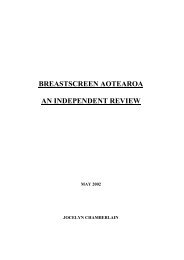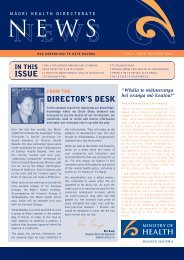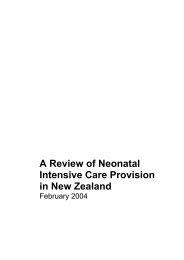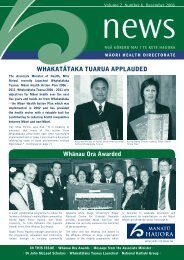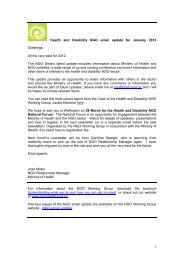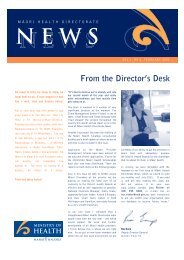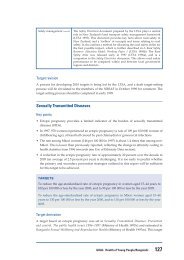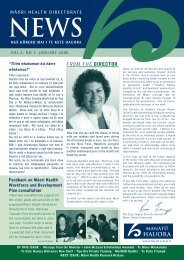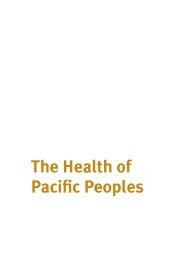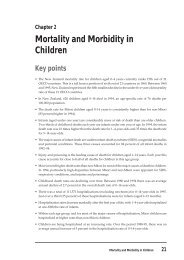Document for PDF - Ministry of Health
Document for PDF - Ministry of Health
Document for PDF - Ministry of Health
Create successful ePaper yourself
Turn your PDF publications into a flip-book with our unique Google optimized e-Paper software.
at nearly twice that <strong>of</strong> non-Maori and equivalent<br />
to New Zealand males.<br />
Coronary artery disease can be treated by drugs,<br />
angioplasty (PTCA) and/or coronary artery by-pass<br />
surgery (CABG), depending on the stage <strong>of</strong> the<br />
disease. Treatment <strong>for</strong> coronary artery disease spans<br />
the primary, secondary and tertiary sectors.<br />
There are a number <strong>of</strong> problems in the provision<br />
<strong>of</strong> cardiac services. A review <strong>of</strong> cardiac services<br />
carried out in late 1998 identified:<br />
• Maori had the lowest intervention rates <strong>for</strong><br />
CABG yet Maori have the highest mortality rates<br />
from coronary artery disease.<br />
• Regional variations in waiting lists <strong>for</strong> PTCA<br />
and CABG. Canterbury <strong>Health</strong> had the largest<br />
waiting list <strong>for</strong> PTCA and Capital Coast <strong>Health</strong><br />
had the highest waiting list <strong>for</strong> CABG.<br />
• Variation in the public/private intervention rates<br />
<strong>for</strong> both PTCA and CABG which has a regional<br />
impact.<br />
• Cardiology and cardiac surgery services are<br />
inefficiently purchased, mainly separately,<br />
which can lead to inefficiencies in the delivery<br />
<strong>of</strong> cardiac services.<br />
There is fragmentation <strong>of</strong> primary and secondary<br />
care, a lack <strong>of</strong> quality primary care service and a<br />
lack <strong>of</strong> emphasis on rehabilitation. Again, we are<br />
proposing an up-to-date disease state management<br />
approach to management <strong>of</strong> heart disease. The issue<br />
is identified but not actioned. It is third on the<br />
priority list after diabetes and asthma.<br />
Personal <strong>Health</strong>’s Action<br />
• Establish capacity to undertake work.<br />
• Look at promotion <strong>of</strong> pharmaceutical<br />
interventions which reduce hospital admission<br />
and need <strong>for</strong> surgery.<br />
• Implement quality standards with primary care<br />
to ensure patients at risk are given maximum<br />
chance to maintain their health.<br />
Oral <strong>Health</strong>: Focus on Youth<br />
Issues<br />
Oral health services have become progressively out<br />
<strong>of</strong> kilter with changes in society. There have been<br />
few major changes over the last 50 years and they<br />
have become progressively dysfunctional.<br />
In particular, oral health services have failed to<br />
adapt to the growing needs <strong>of</strong> adolescents and<br />
Maori. There are long standing issues around adult<br />
Maori oral health and variations in outpatient and<br />
inpatient services provided by hospitals.<br />
Personal <strong>Health</strong> has seized the opportunity created<br />
by concern about inadequate payment <strong>of</strong> dentists<br />
as an opportunity to review oral health services<br />
from the ground up. This has been very well<br />
received by the sector and has revealed a strong<br />
public health ethos and enthusiasm <strong>for</strong> change in<br />
providers. We have engaged the sector through a<br />
joint working party (a Technical Advisory Group)<br />
with representatives from providers, sector<br />
organisations, the Maori <strong>Health</strong> Commission, and<br />
pr<strong>of</strong>essional bodies. This joint working party has<br />
been highly effective at working through the issues<br />
facing oral health services.<br />
The Personal <strong>Health</strong> initiative has been driven by<br />
a need to reverse the decline in oral health. We<br />
also have a strong desire to link oral health back<br />
into the mainstream <strong>of</strong> health care. An example <strong>of</strong><br />
mainstreaming is a recent initiative to contract with<br />
oral health Well Child providers to educate other<br />
Primary care providers on the importance <strong>of</strong> oral<br />
health. A strategy has been developed in<br />
conjunction with the <strong>Ministry</strong> <strong>of</strong> <strong>Health</strong> and awaits<br />
approval. The strategy identifies the need <strong>for</strong><br />
sustainable funding <strong>for</strong> dentists and opportunities<br />
<strong>for</strong> dental therapists if deregulation occurs.<br />
The <strong>Ministry</strong> <strong>of</strong> Education wants to transfer<br />
purchasing responsibility <strong>for</strong> school dental clinics<br />
to the health vote. There are currently<br />
inconsistencies between the HFA and WINZ<br />
methods <strong>for</strong> funding low-income adult dental care,<br />
resulting in confusion <strong>for</strong> providers and consumers.<br />
Personal <strong>Health</strong>’s Action<br />
• Developing more appropriate services,<br />
especially educational methods and<br />
preventative services <strong>for</strong> Maori.<br />
Existing successful services <strong>for</strong> Maori will be<br />
encouraged and duplicated.<br />
• Publicly consulting on options <strong>for</strong> service<br />
provision to encourage teenagers and children<br />
to access services.<br />
HFA Improving Our <strong>Health</strong> 31



